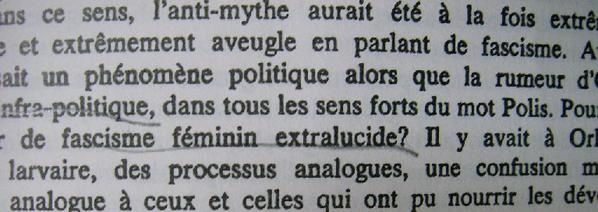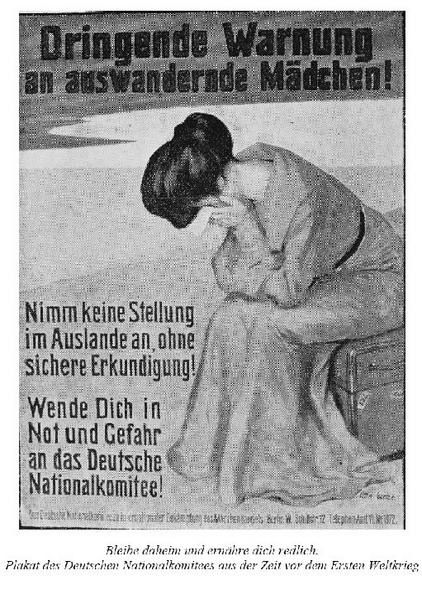18 mai 2008
7
18
/05
/mai
/2008
00:17
The rumeur described in this book spread in 1969 in the town of Orleans and consisted in a story whereby innocent girls would be drugged in Jewish clothes shops and dragged through an underground tunnel system to be sold as sex slaves. Contacted by anti-racist and Jewish associations and institutions, Morin and a group of researchers set out to Orleans to explain this modern medieval rumor (Morin, 1969: 109)

Morin sets out to explain the anti-Semitic nature of the rumeur d’Orléans and naturally does not for one moment doubt, the girls had been really kidnapped by a Jewish mafia. Paradoxically, and even if Morin understands the erotic and anti-emancipatory undertones of white slavery, he seems to believe that this phenomenon really exists, and is a maquereau-marsellais-corse specialty. In her book on white slavery, Margaret Stange describes instead the anti-Semitic aspect as a constant in the literature of white slavery, especially in its European version, where it was also tinged with anti-migrant tones. Morin has interestingly no difficulty in seeing through the antisemitic "rumour" but does not manage to deconstruct "white slavery" as a myth as well.

A second major problem of Morin's narrative is that he retains, explicitly without proof, that the rumor originated in the victims themselves. He is convinced that the young girls would invent such stories to make their mothers even more skeptical about their fashion and life choices. But why would girls, who might actually really want to go into one of these shops and get the hell out of Orléans invent such a rumour? Morin with much insight describes the town of Orléans as suffering a big problem of migration at the time, as many other province towns, where many women would go to find work in the big cities. Rumours such as white slavery were rather a form of social control of these woman.
In fact Morin sets out to discover why a juvenile feminine fantasma (Morin, 1969:107) would have such an appeal. “Ce que nous a appris Orléans c’est notre ignorance des fantasmes de cet autre sexe, que nous fréquentons sans cesse et que nous aimons tant…” (Morin, 1969:103).
Even if Morin is speaking in the name of a researcher group which included women, he manages shamelessly this gallant approach to female mystique. Did the women researches also have the same fantasmas? I doubt so. Did they have an erotic approach to the changing rooms of women’s clothing stores like Morin who manages to set up the whole décor as if it was strip tease?
The myth of white slavery speaks amply of men’s erotic dreams.

18 mai 2008
7
18
/05
/mai
/2008
00:03
White Slavery, a supposed “international traffic in European and North American women, in which women were moved into lives of sexual exploitation” is found recurrently as a topic around the beginning of the century. Legislation like the Mann Act was passed 1910 when the US banned the interstate transport of women for “immoral purposes" and it was evoked recently in the Spitzer scandal.
White slavery was the theme of b-literature and yellow journalism even if investigations could never prove its existence like it  was typically related. But the story had sex appeal, it helped keep women afraid (in a time were the advancement of the feminist cause was gaining importance) and it vehicled an anti-Semitic and a conservative anticapitalist critique full of conspiracies and powerful multinational corporations. The fact white slavery was never really discovered anywhere seemed to sustain this thesis of a secret prostitution ring that would steal “our” women. In her book Personal Property, Margit Stange demonstrates that the issues surrounding white slavery included the commoditization of women and their body and their full insertion in the bustling capitalist market.
was typically related. But the story had sex appeal, it helped keep women afraid (in a time were the advancement of the feminist cause was gaining importance) and it vehicled an anti-Semitic and a conservative anticapitalist critique full of conspiracies and powerful multinational corporations. The fact white slavery was never really discovered anywhere seemed to sustain this thesis of a secret prostitution ring that would steal “our” women. In her book Personal Property, Margit Stange demonstrates that the issues surrounding white slavery included the commoditization of women and their body and their full insertion in the bustling capitalist market.
 Reports of the existence of these rumors persisted well into the 60s as Edgar Morin describes in the Rumeur d’Orleans. After the appearance in the town of Orleans of a rumor relating Jewish clothes shops with a case of white slavery, a group of sociologists went there to do an inquiry. Morin relates white slavery to the angst of Orléans, a little incoherent city near Paris, of the emancipation and migration of women. He finds the origin of the myth in a "feminile fantasma". What Morin really sets out to understand is how it could have become such an anti-Semitic medieval rumor.
Reports of the existence of these rumors persisted well into the 60s as Edgar Morin describes in the Rumeur d’Orleans. After the appearance in the town of Orleans of a rumor relating Jewish clothes shops with a case of white slavery, a group of sociologists went there to do an inquiry. Morin relates white slavery to the angst of Orléans, a little incoherent city near Paris, of the emancipation and migration of women. He finds the origin of the myth in a "feminile fantasma". What Morin really sets out to understand is how it could have become such an anti-Semitic medieval rumor.
In White Slavery Trade. Biography of a Social Problem, Jazbinsek describes how after this last breakout in the 60s the theme of white slavery disappeared. Some of its main characteristics were transferred to the concept of “human traffic”.
Journalists write similar accounts to the ones Jazbinsek analyzed of the beginning of the century and associations all over the world have opened to cater for the victims while concerned VIPs like Emma Gordon Thompson have done provocative commercials where she lays naked in fear with blues and marks of a beating. Human traffic was very quickly considered in a UN protocol against organized (arms and drugs) as a crime. It is now prosecuted all over the world and it is a notably used instrument to bust brothels and control borders.

22 février 2008
5
22
/02
/février
/2008
02:03
A friend just sent me the most interesting article on human traffic I have read in a long long time. Jazbinsek from the Working Group on Metropolitan Studies in the Wissenschaftszentrum Berlin analyses:
White Slavery Trade. Biography of a Social Problem
 Around 1900 it was widely considered a great social problem that young women ran the risk of being abducted and sold to brothels. The resulting world-wide campaigns against so-called white slavery (in German internationaler Mädchenhandel), however, was based on mere fiction. German criminologists and anglo-american social scientists have proven that forced prostitution as a form of organized crime per se did not exist. Yet the belief in this myth was kept alive for political reasons. On the one hand, the horror story of the foreign white slave trader was used to mobilize resentment against foreigners. On the other hand, the campaign for the rescue of innocent girls was directed against social movements that demanded the acknowledgment of prostitution as a profession. The author has investigated the biography of the social problem „white slavery trade“ up to the present. The starting point of his case study is a contribution to the Berlin series of publications, Grossstadt-Dokumente, from 1908, which dealt with the phenomenon of white slavery trade.
Around 1900 it was widely considered a great social problem that young women ran the risk of being abducted and sold to brothels. The resulting world-wide campaigns against so-called white slavery (in German internationaler Mädchenhandel), however, was based on mere fiction. German criminologists and anglo-american social scientists have proven that forced prostitution as a form of organized crime per se did not exist. Yet the belief in this myth was kept alive for political reasons. On the one hand, the horror story of the foreign white slave trader was used to mobilize resentment against foreigners. On the other hand, the campaign for the rescue of innocent girls was directed against social movements that demanded the acknowledgment of prostitution as a profession. The author has investigated the biography of the social problem „white slavery trade“ up to the present. The starting point of his case study is a contribution to the Berlin series of publications, Grossstadt-Dokumente, from 1908, which dealt with the phenomenon of white slavery trade.
more
Jazbinsek offers a historical reconstruction of the social problem that what was called white slavery, or traite des blanches, trata de blancas at the beginning of the 19th century and now human traffic. It's victims where young women migrating to the cities to work. The study highlights the role of "investigative" yellow journalism, pornography, anti-prostitutions groups, religion and patriarchal morals. The Victorian moral reaction against the emancipation of women and the rise of migration to the cities was the cause of rumours, press campaigns and police actions against women.
"stay at home and eat wisely" Poster of the German National Comittee before the 1WW. It reads "Urgent Warning to migrating girls". And underneath "Don't take a position abroad before sure information! in danger turn to the German National Comittee.





